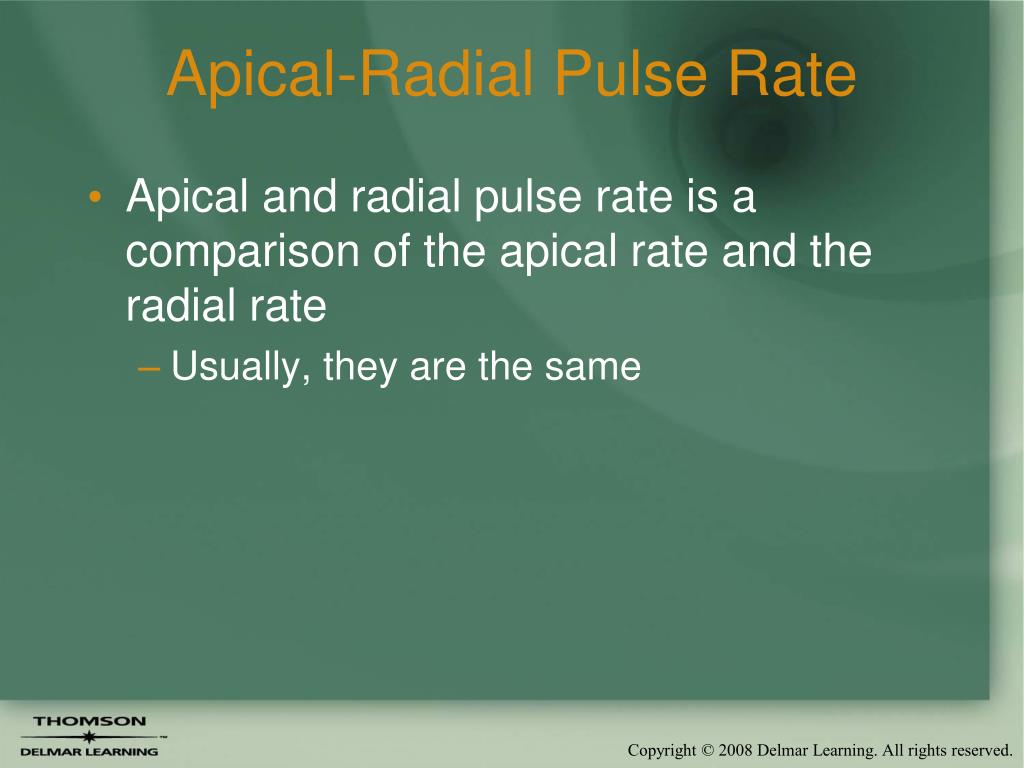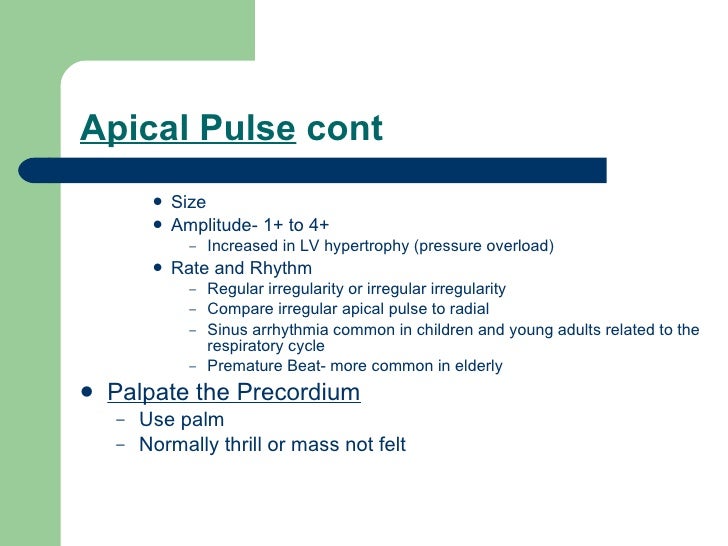Vital Signs
Vital Signs are a basic component of assessment of physiological and psychological health of a client. Body temperature, pulse, respiration and blood pressure are the signs of life. Assessment of vital signs allows the nurse to:
1. Identify specific life threatening conditions and plan the needing nursing interventions.
2. Detect changes in the client’s health status.
Vital signs/cardinal signs in a normal healthy individual remain constant. They are called “vital signs” because of the following reasons:
1. These findings are governed by vital organs and often reveal even the slightest deviation from the normal body functions.
Bs player windows 10.
2. The changes in the condition of the client, improvement or regression may be detected by the observation of these signs.
3. Significant variations in these findings may indicate problems relating to insufficient consumption of oxygen, blood depletion, electrolyte imbalance, bacterial invasion and other problems.
The apical pulse is assessed with auscultation and the point of maximum intensity for the adult is on the left side of the chest at the fifth intercostal space. This point differs somewhat along the lifespan until adolescence and during later years secondary to an enlarged heart. The normal parameters for pulse rates along the life span are. If there is a difference between the apical and radial pulse rates, subtract the radial pulse from the apical pulse rate to obtain the pulse deficit. Document findings in patient's record including site, pulse rate, rhythm and volume (full/bounding, weak/thready). Identify pulse patterns as: Normal - 60 to 80 beats per minute. We are usually not aware of our pulse, with normal heart rate being 60-80 beats per minute, but when the rhythm does go awry, it’s easy to notice irregularities. However, some abnormal heartbeat patterns may be silent and go undetected. The normal apex beat is a localised pulsation in the normal location as described above. Here are some abnormal characters (please refer to the algorithm shown in the picture below, too): Tapping Apex – This is an almost normal apex beat with a palpable first heart sound.
4. Through these signs, specific information may be obtained that will help in the diagnosis of disease, the result of treatment, medications and nursing care.
5. Even the client’s emotional state may also cause a significant variation in the symptoms.
The normal body temperature is 37 degree celcius in adults
The normal pulse is 72/minute in adults
The normal blood pressure is 120/80 mm of Hg in adults
Discussing heart rate vs. pulse can be a confusing when trying to decipher the two. Essentially, they are two separate measurements and indicators of health but are closely related. The heart is a muscular pump that with each heart beat pumps blood throughout the body. A pulse is what you feel over an artery as the pressure increases within it following each heartbeat.
For adults, the general consensus is a normal pulse rate falls into the range of 60 to 100 beats per minute. Having a rate that exceeds this is known as tachycardia – a heart rate that exceeds normal resting rate. Tachycardia may be caused by hypovolemia, rises in body temperature, stress, heart disease, exercise, or even when using certain medication.
What are heart and pulse rates?
Heart rate is measured by counting the number of heart beats in one minute; beats per minute. A heart beat is the sounds of the heart valves opening and closing in response to pressure differences. During each heart beat blood is pushed throughout the body, augmenting blood pressure and therefore the pulse rate in the main arteries. Accurate heart rates can be measured from the thorax with a heart rate transmitter or by electrocardiograph (ECG/EKG).
Normal Apical Pulse Range
Pulse rate is the measure palpable blood pressure increases throughout the body that occurs with each heartbeat. Pulse rate is basically the physical sensation of a heart beat felt through the arterial vascular system. Pulse can be measured from the earlobe with a pulse meter known as a Photo Reflectance or Infrared Sensor Monitor. Your pulse can vary with body movements and should, therefore, be measured while at rest. An easy way to measure pulse rate is to place your fingers at the base of the thumb at the wrist, or at the neck, just next to your windpipe.
Heart rate vs pulse rate: The difference
The cardiovascular system is a complex network of specialized muscle and tissue. They all work together to ensure that oxygen-rich blood is being supplied to the far reaches of the human body. No organ is more important than the brain, which is why when our blood pressure becomes too low we often collapse or faint so our head will be on a lower plane, horizontally on the floor with the rest of the body. This is to circumvent the effects of gravity and help the heart pump blood to the brain more easily.
Our heart rate and pulse rate are key factors to ensuring blood pressure is high enough to sustain the perfusion of blood to all organs of the human body. While both are considered similar each represents a different mechanic of how the body is responding to differences in blood pressure.

Under normal condition, both the heart rate and pulse rate tend to be the same, but in conditions that affect either only the heart or only the blood vessels, these values may differ. The heart rate is the measured value obtained per minute when listening to the sounds the heart produces. The pulse rate is the measured value per minute when palpating the arterial vessels through the sense of touch and is a good indicator of various blood pressures throughout the body.
Your pulse rate is dependent on your heart rate. For if your heart were to stop beating you will not produce a pulse as there is no blood being pumped through the arterial vascular system.
Individuals with certain heart conditions where the heart does not efficiently pump blood with each contraction, they may have a pulse that is lower than the measured heart rate. Heart rate can also be affected by other factors such as body mass, athleticism, alcohol use, and smoking cigarettes.
Normal Apical Pulse Toddler
In normal healthy individuals, the pulse rate can be used to measure heart rate.

| Heart Rate | Pulse Rate | |
|---|---|---|
| Definition | The number of times the heart contracts and expands over a period of time | Arterial pressure that can be observed in a human body |
| Instrument | Using a heart rate monitor or with an EKG machine. | Using a pulse meter or a photo-reflectance or infrared monitor. |
| Activity | Changes dynamically with any kind of physical activity | Changes dynamically with any kind of physical activity |
| Range | The rate of heart should be around 60-100 bpm to be considered normal | The level of the pulse would be at a similar range as the heart rate in a healthy individual |

How are heart rate and pulse rate related?
The source of a pulse is your heart. It can be understood as having a ripple effect throughout your vascular system much like throwing a stone into a pond. But the human body is vastly more complex as under normal operating conditions it has to maintain a certain level of homeostasis- a stable equilibrium between interdependent elements.
Health care providers have learned to use heart rate and pulse rate as two separate characteristics. While they are intrinsically bound they can differ in certain ways they may not fall in line with the current health status of the other.
Heart rates vary by age, with ranges for newborns and older adults differing vastly. Yet these are all still considered normal heart rate values. Bluetooth driver free download for windows 10. A normal newborn heart rate falls between 70-190 beats per min, while an adults heart rate falls between 60-100 beats per minute. This reference for adults can be more variable as seen in an athletic individual who’s normal resting heart rate has reached a level that is below normal owing to their greater level of fitness.
Effects of various health conditions and exercises on heart and pulse rate
Our cardiovascular system is a dynamic and resilient structure capable of overcoming several short comings. We see this first hand in those who live unhealthy lifestyles, eating foods high in saturated fat and cholesterol and not getting enough exercise. These individuals have weakened their vascular system by clogging their blood vessels with plaque and degrading blood vessel integrity leading to diagnosis such as hypertension (high blood pressure). In cases such as these, the heart has to work extra hard to pass blood through narrow blood vessels. it achieves this by increasing the force it has to push, which leads to a rise in blood pressure. This rise occurs over years of neglect of good health habits.
The dynamic nature of the cardiovascular system works in the immediate as well. This can be appreciated as temporary rises in blood pressure while we exercise to help improve blood flow or during the time of anxiety were our body feels it needs to get ready to either fight or run away. Variations in temperature also have a distinct effect on heart rate as one UK study found that a one-degree change in body temperature could increase or lower the pulse as much as 10 beats per minute.

The things we consume such as cigarette smoke, alcohol, and various drugs can also affect your heart rate on a chemical level. Sometimes this can be dangerously so. Much like other muscles in the body, the heart is also connected to the central nervous system which can be influenced by chemical augmentation.
While heart rate and pulse rate is seen as two sides of the same coin, they could be thought of as different values that are related but can vary depending on the circumstance. Our body is a complex organism composed of a rich network of interconnecting organs and tissue all working together to help keep you alive.
